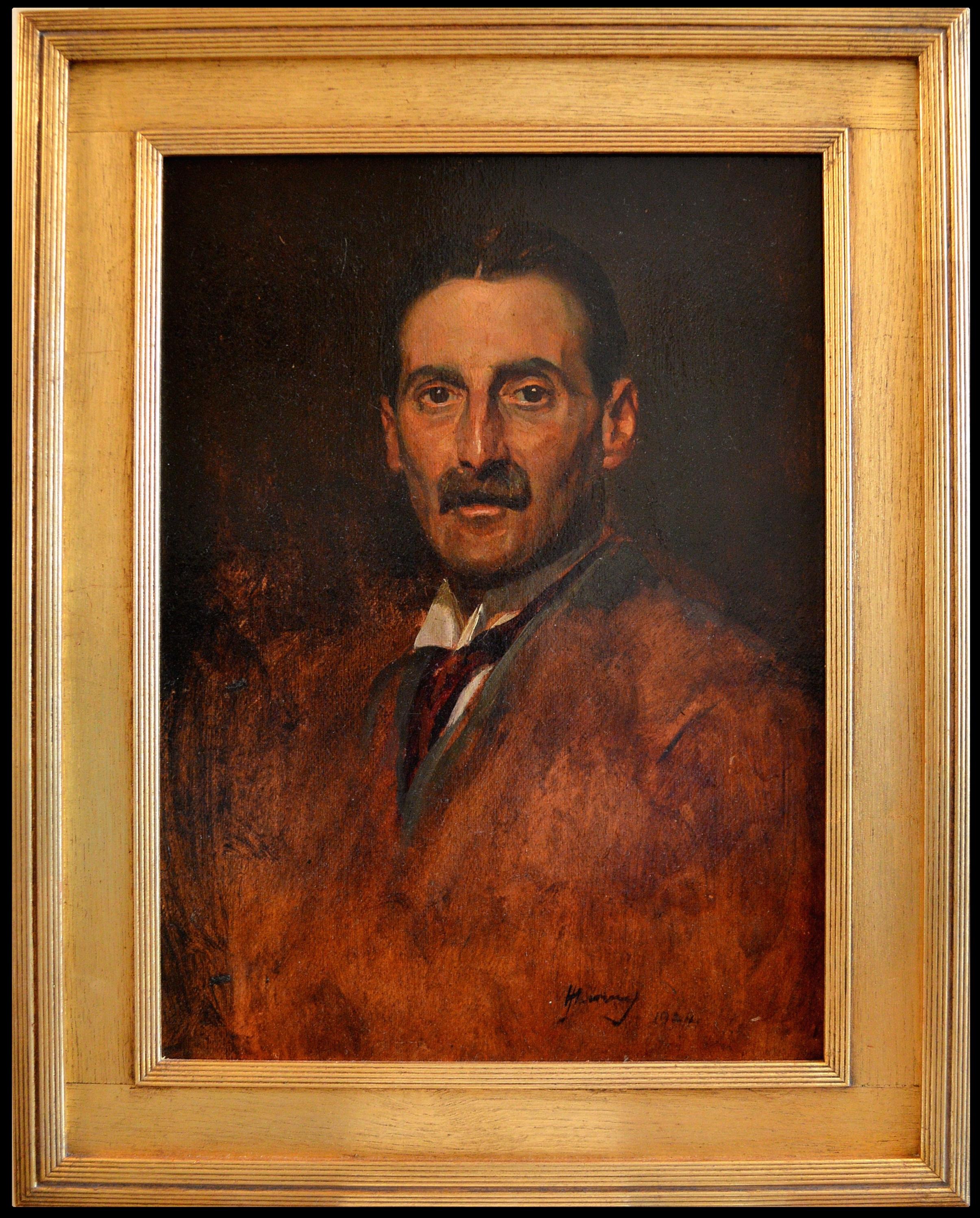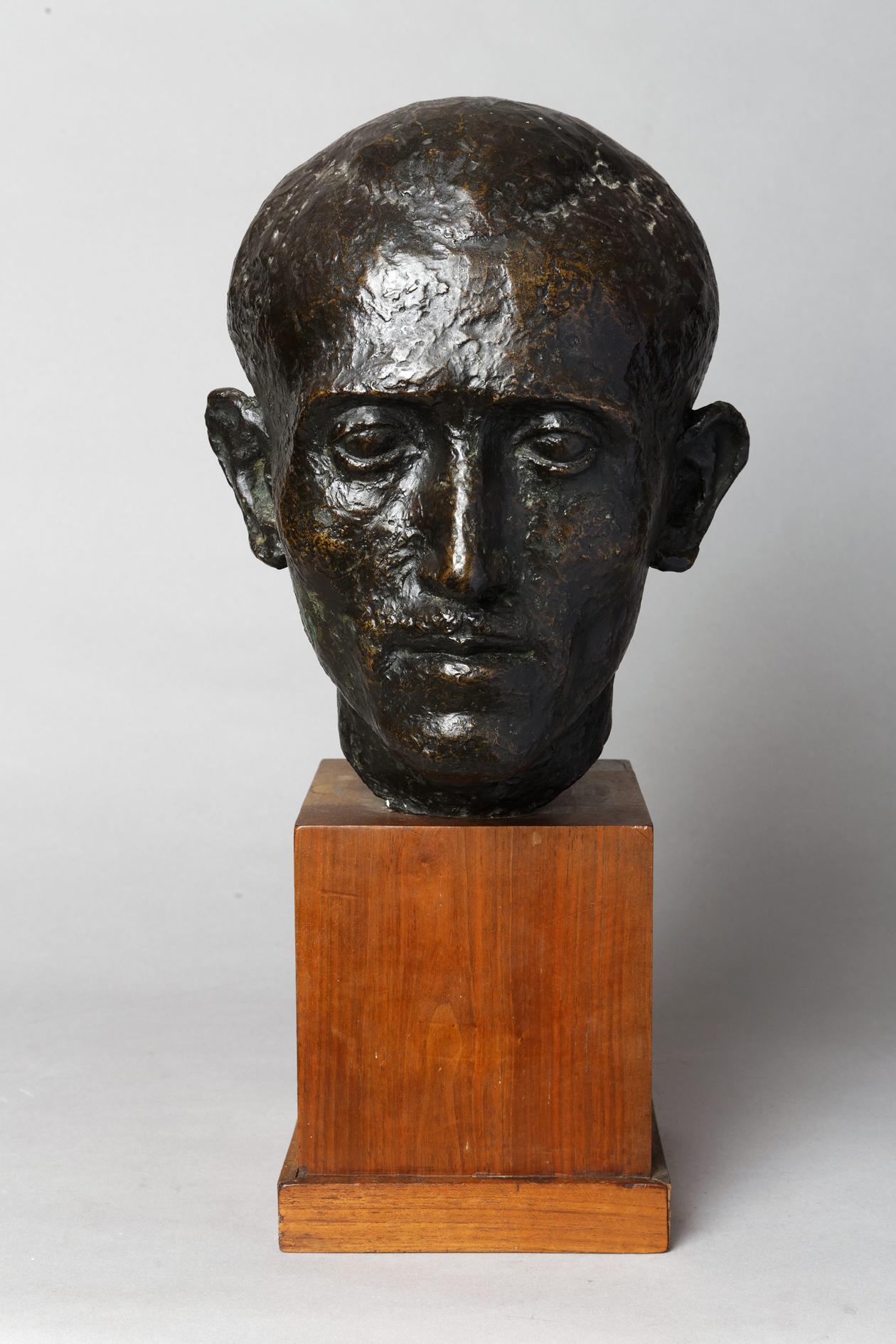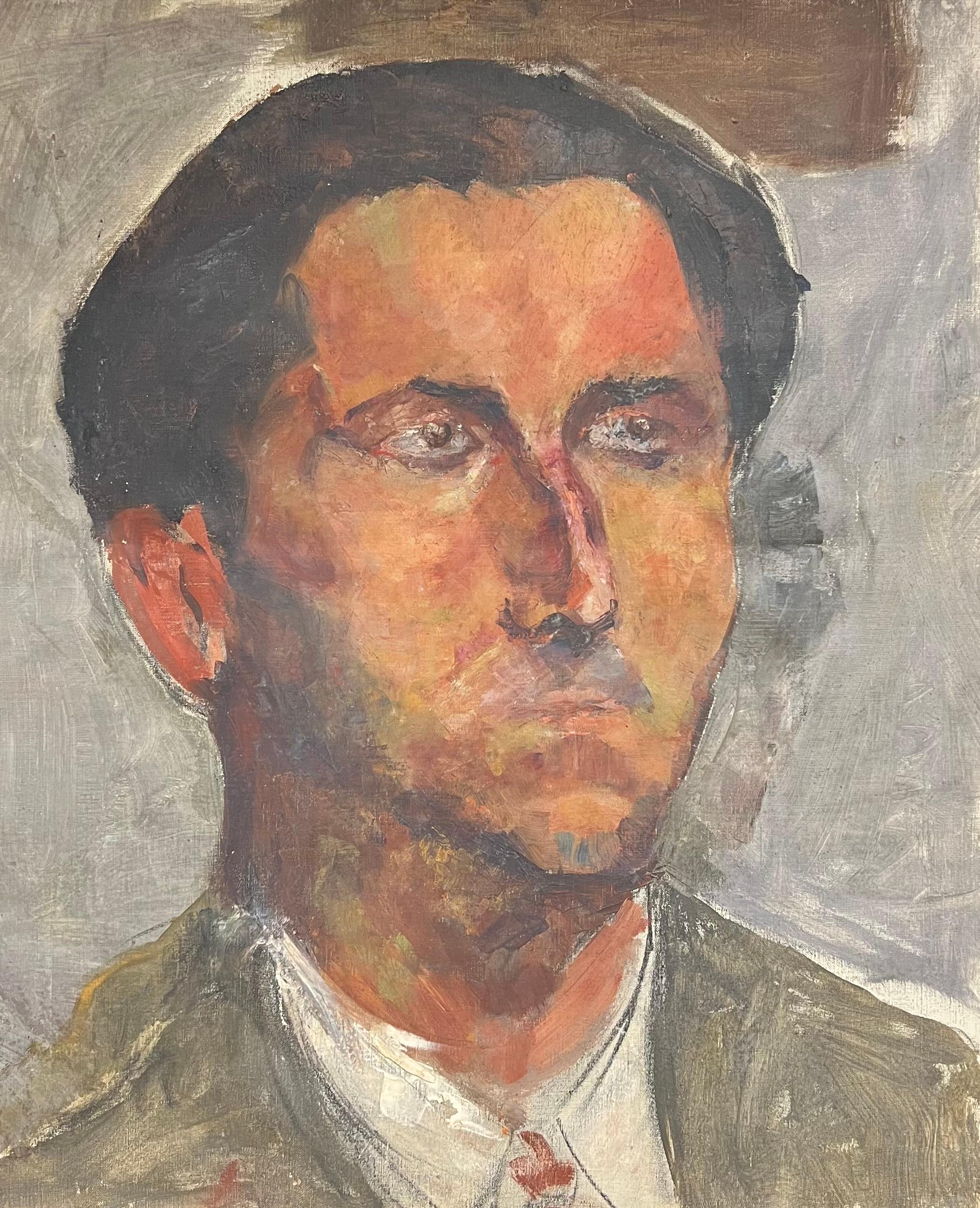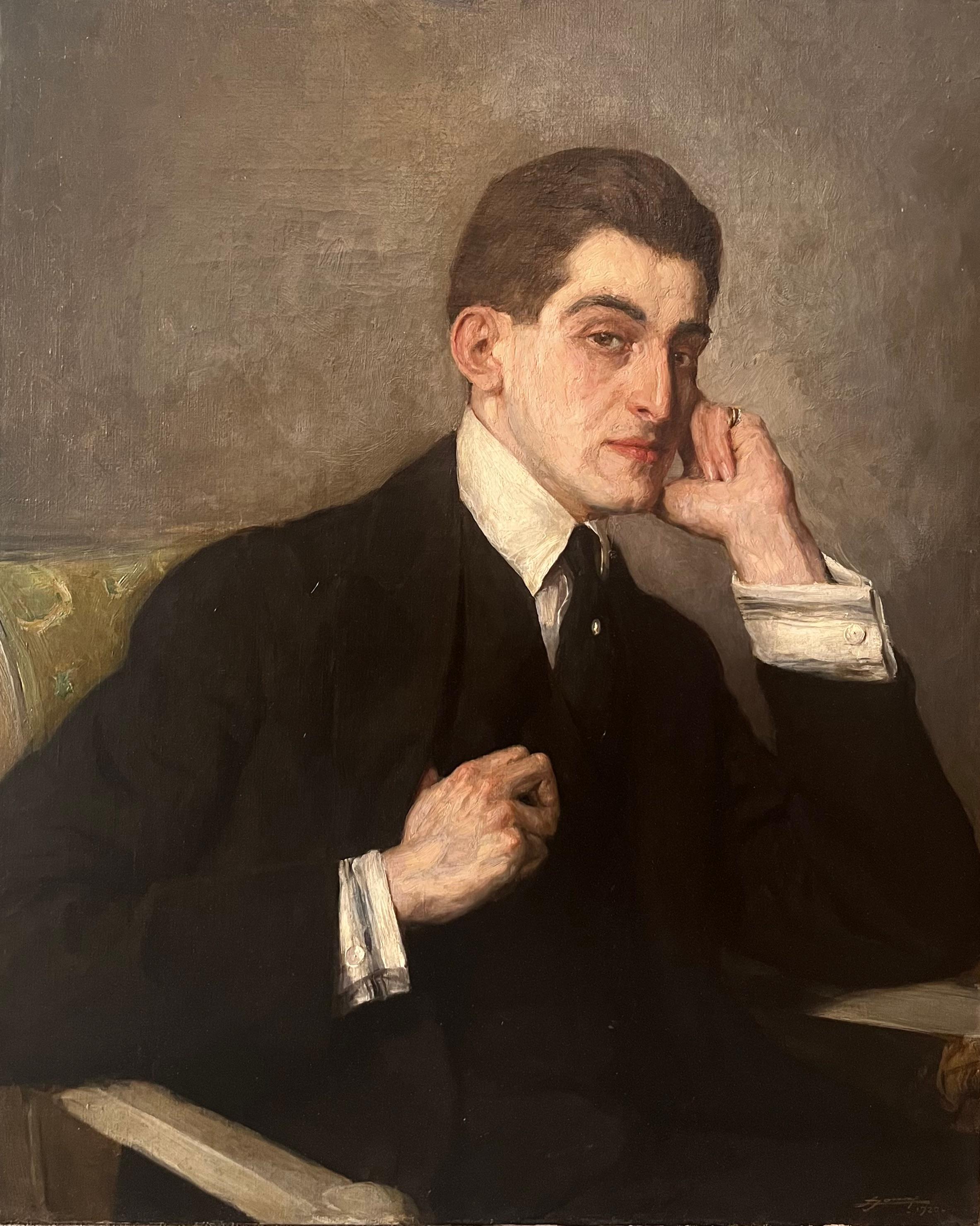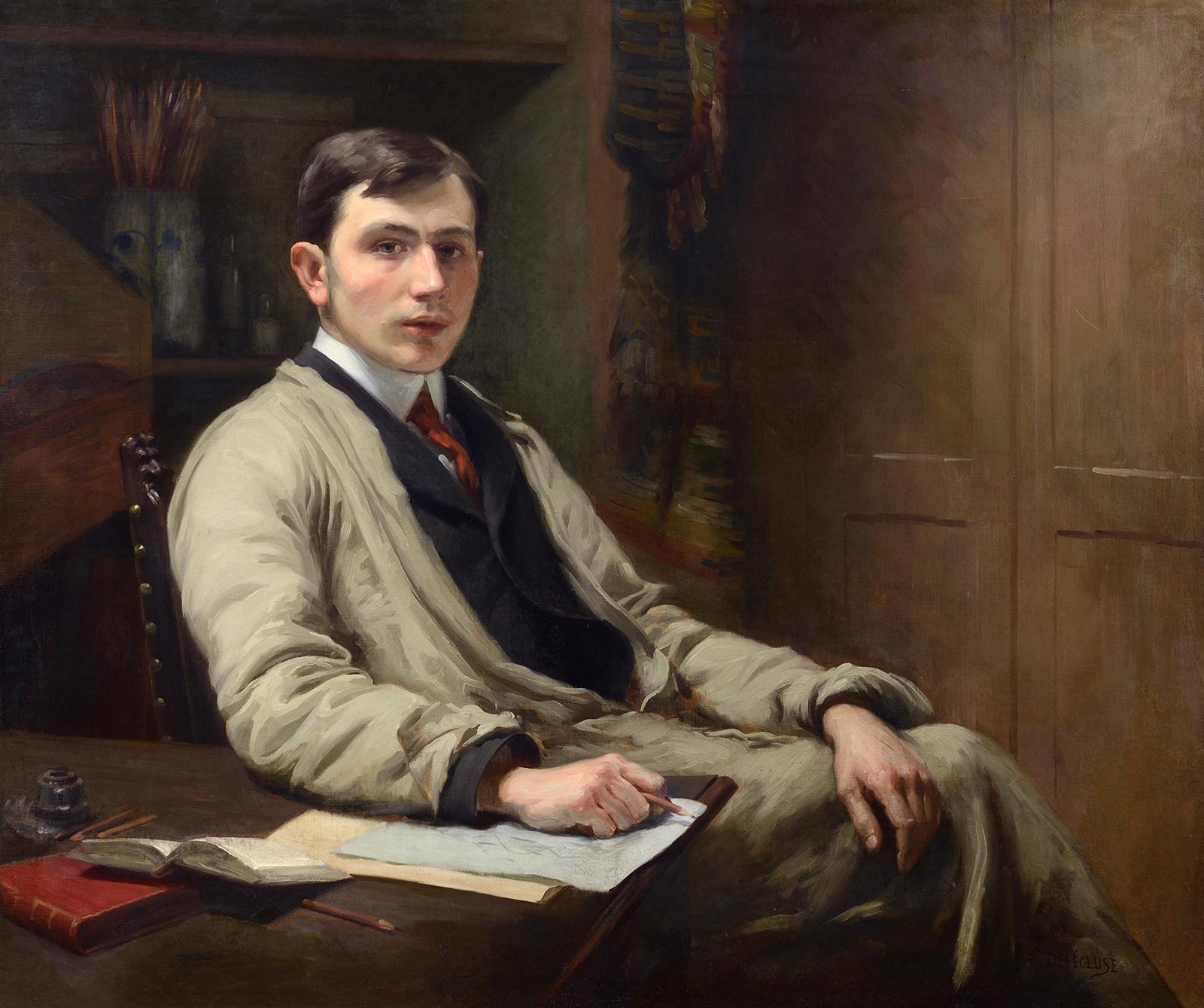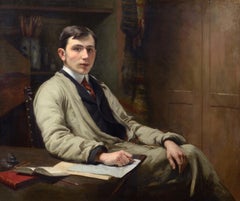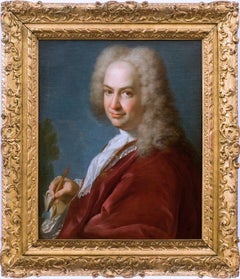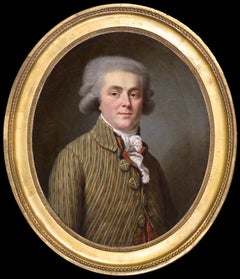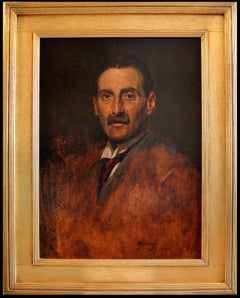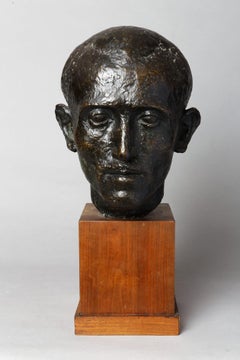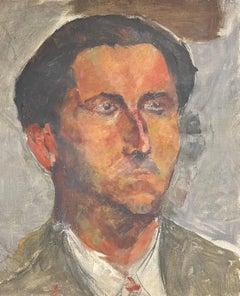Items Similar to Portrait of a French man
Want more images or videos?
Request additional images or videos from the seller
1 of 12
Jean DespujolsPortrait of a French manCirca 1920/25
Circa 1920/25
$5,323.96
£4,047.10
€4,500
CA$7,482.03
A$8,136.88
CHF 4,286.69
MX$98,823.90
NOK 53,892.33
SEK 50,519.71
DKK 34,460.40
About the Item
Jean DESPUJOLS
(Salles 1886 – Shreveport 1965)
Portrait of a Henri Martin, mayor of Saint Médard en Jalles (Gironde)
Oil on canvas
H. 75 cm; L. 60 cm
Signed lower right
around 1920/25
Bibliography: Esprit des Landes, Jacques Sargos, Editions l'Horizon Chimère, 2010, reproduced p.274
Jean Despujols began his training under the gaze of Paul Quinsac at the Ecole des fine arts of Bordeaux. Flying towards new horizons, he joined the School of Fine Arts in Paris in May 1912, where he studied in the studio of Gabriel Ferrier. In 1914, he won a second first Grand Prix de Rome for painting, but was like many of his generation, mobilized during the First World War as a machine gunner. He joined the Villa Medici in Rome with his friend Jean Dupas in 1919 and worked there until 1923. Back in France, he exhibited regularly at the Salon of French Artists, the Salon des Indépendants and the Salon des Tuileries as well as in many exhibitions abroad, even in Asia. He participated in several decorative projects: he painted a monumental Agriculture for the tower of Bordeaux at the International Exhibition of Modern Decorative and Industrial Arts in 1925, and in 1936 produced another mural on La Santé for the town hall annex of the 14th arrondissement. from Paris. He gave lessons from 1924 to 1936 at the American art school in Fontainebleau and received the same year 1936 the Indochina prize which allowed him to stay in the French colonies of Asia, where he produced several hundred works. in an exotic flavor — many preserved at Shreveport, Meadows Museum. Returning to France three years later, he designed an exhibition project of his colonial paintings and drawings at the Orangerie des Tuileries, which was finally abandoned after the outbreak of the Second World War. He settled permanently in the United States in 1941 and joined his wife Milicent Jordan, an American pianist he met at the art school in Fontainebleau. He was finally naturalized American in 1945, and pursued a career as a portrait painter and composer of piano pieces, along with his wife. He died in Louisiana in 1965. We owe him The Epitinikaire or Introduction to Integral Enjoyment (2 volumes). He wrote several poems and philosophical, sociopolitical, educational or aesthetic works. Atypical, our portrait of Landes owner is so in more ways than one.
The man who is currently mayor of the town of Saint-Médard-en-Jalles seems to be in the middle of a speech. The half-open mouth of this man in the green suit can assume that he is in discussion with an external interlocutor, which is confirmed by his look which is not intended for us. Original it is even more so by the external context in which it is found. Unique to our knowledge, it is represented in the heart of moors, in a marshy cut with a few pines rising in the background. What better idea to represent a man attached to his land than to 'sit him' in his context?! Also note the typical frame of the period which was painted in imitation of pine bark. A complete work.
- Creator:Jean Despujols (1886-1965, American)
- Creation Year:Circa 1920/25
- Dimensions:Height: 28.35 in (72 cm)Width: 23.63 in (60 cm)
- Medium:
- Movement & Style:
- Period:
- Condition:
- Gallery Location:BELEYMAS, FR
- Reference Number:1stDibs: LU1857214572642
About the Seller
3.0
Vetted Professional Seller
Every seller passes strict standards for authenticity and reliability
Established in 2017
1stDibs seller since 2022
6 sales on 1stDibs
Typical response time: 10 hours
- ShippingRetrieving quote...Shipping from: BELEYMAS, France
- Return Policy
Authenticity Guarantee
In the unlikely event there’s an issue with an item’s authenticity, contact us within 1 year for a full refund. DetailsMoney-Back Guarantee
If your item is not as described, is damaged in transit, or does not arrive, contact us within 7 days for a full refund. Details24-Hour Cancellation
You have a 24-hour grace period in which to reconsider your purchase, with no questions asked.Vetted Professional Sellers
Our world-class sellers must adhere to strict standards for service and quality, maintaining the integrity of our listings.Price-Match Guarantee
If you find that a seller listed the same item for a lower price elsewhere, we’ll match it.Trusted Global Delivery
Our best-in-class carrier network provides specialized shipping options worldwide, including custom delivery.More From This Seller
View AllPortrait of young man - The artist's son
Located in BELEYMAS, FR
Auguste-Joseph Delécluse
(Roubaix 1855 - Paris 1928)
Portrait of the artist's son, Eugène Delécluse
Oil on canvas
H. 98 cm; W. 116 cm
Signed lower right
1903
Exhibition: 1903, Salon...
Category
Early 1900s French School Portrait Paintings
Materials
Canvas, Oil
Presumed artist self-portrait
Located in BELEYMAS, FR
Louis-Gabriel BLANCHET
(Versailles, 1701 – Rome, 1772)
Presumed self-portrait of the artist
Oil on canvas
H. 73 cm; W. 60 cm
Circa 1730
Originally presented in a Restoration period frame with a "Mignard" cartouche, this beautiful painting initially appeared to us as a work from northern Italy. However, it exuded a rather French form of refinement, suggesting that its artist may have assimilated a dual influence from both sides of the Alps.
We thank our colleague and friend Philippe Mendès for spontaneously and judiciously "bringing out" the name of Louis-Gabriel Blanchet, a Romanized French portraitist, whose spirit and stylistic characteristics we clearly recognize here.
Blanchet's "French" years, before his final departure for Rome in 1728, following his winning of the second Grand Prix for painting after Subleyras in 1727, are extremely poorly documented. His father, Gabriel, was valet to Blouin, himself Louis XIV's first valet at the time. According to Thierry Lefrançois, Blanchet was one of the few students of Nicolas Bertin (1667-1736), whose studio he is said to have joined in the early 1720s. At a baptism on March 24, 1724, where he was godfather, he is mentioned as a painter in the picture store of the Duke of Antin, the director of buildings between 1708 and 1736. At this time, he was probably already married to Jeanne Quément, with whom he had a daughter also named Jeanne, who would marry Nicolas Aviet, the son of a valet in the queen's wardrobe, in Versailles in 1738.
When Blanchet arrived in Rome in October 1728, he was accompanied by Subleyras, Trémolières, and Slodtz. He enjoyed the goodwill of Vleughels, the director of the Académie de France, which had been based at the Palazzo Mancini since 1725, even though the latter was not always kind to our resident. From 1732, he was under the protection of the Duke of Saint-Aignan when he took up his post as ambassador to Rome. Along with Slodtz and Subleyras, they formed a trio of friends, joined by Joseph Vernet shortly after his arrival in Rome in 1734. Slodtz and Blanchet, on the occasion of Subleyras's marriage in 1739, were there to attest that their friend was not bound by any marital commitment, and Blanchet was a witness at Vernet's wedding in 1745.
It is most likely from these early years in Rome that our portrait of the artist dates, the expression and turn of his face irresistibly reminiscent of a self-portrait. The still relatively youthful features may correspond to Blanchet's thirty-something years, and the fluffy wig was still fashionable at this time.
The painting fits well with the depiction of a young painter wanting to display both the beginnings of success and a certain simplicity or restraint. A slight smile expresses a form of assurance in this man with a gentle, sincere gaze and a face radiating a keen sense of wit. We find here the air of intimacy present in almost all of Blanchet's portraits, even those from the 1750s and 1760s, as well as an almost complicity with the viewer. The spirit of the painting is quite close to that of the presumed portrait of Bouchardon (painted around 1730) and the portrait of Pannini, painted in 1736, but it possesses a more natural quality, notably thanks to the absence of decorum. Our work exhibits the characteristics of Blanchet's paintings: elegance, luminosity (especially in the whites), vibrant and refined colors (here, the harmony of the garnet of the garment and the slate blue of the background, whose uniformity is tempered by a very sketched landscape and a grove of greenery), light complexions, rather rosy cheekbones, often full lips, and rather tight framing.
According to the Academy's rules, Blanchet's stay should have ended in the spring of 1732, but, for reasons unknown, he remained in the Eternal City until his death, as did his friend Subleyras, with whom he shared accommodation until the late 1730s. The latter regularly called upon him to collaborate on his paintings, such as The Meal at Simon's. Through Saint-Aignan's intervention, Blanchet was employed in the late 1730s by the Stuart princely family, then exiled in Italy. He notably produced copies (now lost) after Liotard of the portraits of Charles Edward and Henry Benedict, the sons of James III Stuart. The latter also commissioned three other portraits (now in the National Portrait Gallery in London), whose more formal character contrasts with the intimate spirit of Blanchet's portraits. Blanchet frequented English painters, such as the landscape painter Richard Wilson, and studied with the Scottish portraitist Katherine Read...
Category
1730s French School Portrait Paintings
Materials
Oil, Canvas
The painter (self-portrait) sketch
By Jacques Martin-Ferrières
Located in BELEYMAS, FR
Jac MARTIN-FERRIÈRES
(Saint-Paul Cap de Joux 1893 – Neuilly sur Seine 1972)
The Painter (Self-Portrait) - Sketch
Oil on canvas
H. 65 cm; W. 65 cm
Signed lower left, dated 1925
Exhibi...
Category
1920s French School Portrait Paintings
Materials
Canvas, Oil
Portrait of a man during French Revolution
Located in BELEYMAS, FR
Antoine VESTIER, attributed to
(Avallon, 1740 - Paris, 1824)
Portrait of a man under the Revolution
Oil on canvas
H. 46 cm; L. 37 cm
Circa 1793-95
This beautiful unsigned portrait i...
Category
1790s French School Figurative Paintings
Materials
Canvas, Oil
Portrait of baron de Roisin - Gendarmerie general
Located in BELEYMAS, FR
Flemish school of the 19th century
Armorial portrait of Baron Henri de ROISIN (1787-1846)
in the uniform of a general of the gendarmerie (1835)
Oil on canvas
H. 108 cm; W. 90 cm
Bar...
Category
1830s French School Portrait Paintings
Materials
Canvas, Oil
The pianist
Located in BELEYMAS, FR
Jean CLUSEAU-LANAUVE
(Périgueux 1914 - Paris 1997)
The Pianist
Oil on canvas
H. 46 cm; W. 38 cm
Signed lower right. Countersigned, titled, and dated on the back - 1962
Provenance: E...
Category
1960s French School Portrait Paintings
Materials
Oil, Canvas
You May Also Like
Male Portrait, Signed Gennaro Befanio (Naples, 1866 - Paris, 1937), Dated 1936
Located in Firenze, IT
Male Portrait, Signed Gennaro Befanio (Naples, 1866 - Paris, 1937), Dated 1936
Male portrait in oil on canvas, signed in the upper left corner "G. Befanio" and dated 1936.
Likely on...
Category
Early 20th Century Art Deco Portrait Paintings
Materials
Canvas, Oil
Portrait of a Gentleman - 1920's Antique English Art Deco Oil on Board Painting
Located in Sevenoaks, GB
A fine 1920's oil on board portrait of a smartly dressed gentleman, close to the work of James Abbott McNeil Whistler.
The work is indistinctly signed and dated 1924 lower right. P...
Category
1920s Portrait Paintings
Materials
Oil, Board
Portrait of a Man
Located in PARIS, FR
Portrait of a Man
by Marcel GIMOND (1894-1961)
Bronze with a very nuanced dark brown patina
signed on the neck with the monogram "MG"
period cast by "Meroni Radice, cire perdue, Par...
Category
1930s French School Figurative Sculptures
Materials
Bronze
Expressive Male Portrait Mid-20th Century French Oil Painting
Located in Cirencester, Gloucestershire
Expressive Male Portrait
French, mid 20th century
from the studio collection of Simone Forge (1930's-1950's female French artist)
oil on canvas, unframed
Canvas: 24 x 19.75 inches
Pr...
Category
Mid-20th Century Impressionist Figurative Paintings
Materials
Oil
Men Portrait
By Lucien Jonas
Located in PARIS, FR
Lucien Jonas (1880 - 1947)
Men Portrait
1920
Oil on canvas
81 x 65,5 cm
Signed and dated bottom right
Category
1920s Portrait Paintings
Materials
Oil
Self-Portrait, Modern American Oil Painting by Ben Benn
By Ben Benn
Located in Long Island City, NY
Artist: Ben Benn, Polish/American (1884 - 1983)
Title: Self-Portrait
Year: circa 1920
Medium: Oil on Canvas, signed l.r.
Size: 44 x 30 in. (111.76 x 76.2 cm)
...
Category
1920s Modern Portrait Paintings
Materials
Oil
More Ways To Browse
International Exhibition Of Modern Decorative And Industrial Arts
Antique Green Man
Luxury Pop Art
Man In Hat Painting
Oil Paintings Marilyn Monroe
Portrait Of King George
Antique Mantilla
Gina Palmerin
Guido Reni Oil Painting
Merchant Portrait
Military Oil Portrait
Painting Of Edinburgh
Pembroke College
Picasso Original Oil
Andras David
Aristocratic Portrait Paintings
Full Length Portrait Painting
Kate Moss Painting
